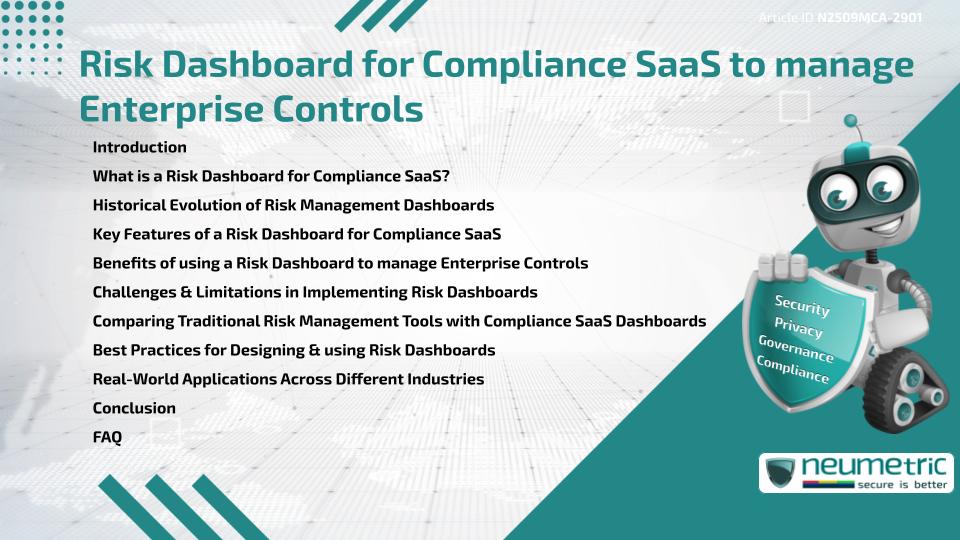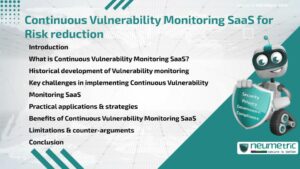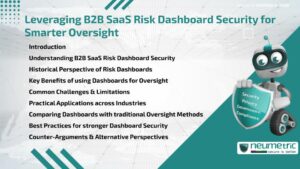Table of Contents
ToggleIntroduction
A Risk Dashboard for Compliance SaaS provides enterprises with a centralized way to monitor, analyze & control Compliance Risks. It serves as a visual & interactive platform that tracks regulatory requirements, identifies Vulnerabilities & ensures Governance Standards are upheld. By integrating automated reporting, real-time analytics & customizable controls, this Dashboard becomes a crucial tool for managing enterprise controls. Organisations use it to simplify Compliance tasks, improve accountability & mitigate Risks that could otherwise harm operations or reputation.
What is a Risk Dashboard for Compliance SaaS?
A Risk Dashboard for Compliance SaaS is a cloud-based solution that offers enterprises a consolidated view of Compliance metrics, internal controls & potential Risks. Unlike static spreadsheets, it is dynamic & interactive. Dashboards highlight areas of concern through graphs, indicators & alerts, allowing decision-makers to act promptly. These tools often include regulatory mapping, Audit tracking & integration with Governance Frameworks to ensure enterprises stay aligned with evolving Standards.
Historical Evolution of Risk Management Dashboards
Risk Dashboards evolved from manual tracking methods such as checklists & paper-based audits. Early enterprise systems relied heavily on static reports, which often became outdated before review. The rise of Compliance-focused software as a service [SaaS] introduced automation & real-time monitoring. Over time, Dashboards became more user-friendly, adopting interactive visualization techniques that helped enterprises not just collect Compliance data but actively manage & respond to it.
Key Features of a Risk Dashboard for Compliance SaaS
A well-designed Risk Dashboard for Compliance SaaS typically includes:
- Real-time monitoring of enterprise controls & Risks
- Automated reporting to reduce manual errors
- Customizable views for different roles & departments
- Regulatory mapping to track Compliance across Frameworks
- Alert systems to flag emerging Risks or breaches
- Audit trail management for Transparency & Accountability
These features collectively support enterprises in aligning their Compliance strategy with both internal & external Standards.
Benefits of using a Risk Dashboard to manage Enterprise Controls
The benefits of adopting a Risk Dashboard for Compliance SaaS include:
- Efficiency: Automation saves time compared to manual Compliance reporting.
- Accuracy: Dashboards reduce human error by centralizing data.
- Transparency: Stakeholders gain visibility into Risk exposure & control performance.
- Adaptability: Enterprises can update Compliance Frameworks in response to new regulations.
- Decision-making: Executives use Dashboards to prioritise Risks & allocate resources effectively.
For enterprises managing hundreds of controls, a Dashboard ensures that Compliance activities remain proactive rather than reactive.
Challenges & Limitations in Implementing Risk Dashboards
Despite their advantages, enterprises may face challenges when implementing a Risk Dashboard for Compliance SaaS. Some common issues include:
- High initial setup & integration costs
- Resistance from Employees accustomed to traditional methods
- Potential data overload if Dashboards are not properly designed
- Difficulty in aligning Dashboards with complex or unique enterprise workflows
Recognizing these limitations allows Organisations to plan more effectively & invest in training, customization & Governance strategies.
Comparing Traditional Risk Management Tools with Compliance SaaS Dashboards
Traditional Risk Management often involved static reports, manual spreadsheets & delayed Audit processes. In contrast, a Risk Dashboard for Compliance SaaS offers interactive visualization, automation & integration with existing enterprise systems. This comparison is similar to moving from paper maps to GPS navigation: while both provide direction, the latter is faster, more accurate & adaptable to real-time conditions.
Best Practices for Designing & using Risk Dashboards
To maximize the value of a Risk Dashboard for Compliance SaaS, enterprises should:
- Define clear objectives before Dashboard deployment
- Limit complexity to avoid overwhelming users
- Provide role-based access to ensure relevant information reaches the right teams
- Continuously update the Dashboard as regulations evolve
- Train staff on how to interpret & act on Dashboard insights
Following these Best Practices ensures the Dashboard becomes a strategic asset rather than just a Compliance checklist.
Real-World Applications Across Different Industries
Enterprises across sectors such as Finance, Healthcare & technology use Risk Dashboards to manage enterprise controls. In Finance, Dashboards track Compliance with banking regulations. In Healthcare, they monitor Patient Data Privacy under Standards like HIPAA. In technology, they ensure adherence to Frameworks such as ISO 27001. Each industry adapts the Dashboard to fit its unique Compliance landscape while benefiting from shared principles of transparency, accuracy & efficiency.
Conclusion
A Risk Dashboard for Compliance SaaS is more than a reporting tool. It is a strategic solution that empowers enterprises to manage controls, reduce Risks & ensure Compliance. By combining automation with accessibility, Dashboards streamline complex regulatory tasks into actionable insights.
Takeaways
- A Risk Dashboard for Compliance SaaS centralizes Compliance management.
- It offers automation, accuracy & real-time monitoring.
- Challenges include setup costs, data overload & change resistance.
- Best Practices focus on clarity, training & continuous updates.
- Different industries adapt Dashboards for unique Compliance needs.
FAQ
What is the purpose of a Risk Dashboard for Compliance SaaS?
Its purpose is to monitor enterprise controls, track Compliance Risks & provide actionable insights for decision-makers.
How does a Risk Dashboard improve enterprise Compliance?
It automates reporting, ensures accuracy & highlights Risks in real time, helping enterprises respond faster.
What industries benefit most from Risk Dashboards?
Finance, Healthcare & Technology sectors benefit greatly, but any industry with regulatory requirements can adopt them.
Can a Risk Dashboard replace manual Compliance processes?
Yes, in many cases it reduces or eliminates manual tracking, but human oversight remains necessary for interpretation & Governance.
What challenges might enterprises face when adopting Dashboards?
Common challenges include high setup costs, integration complexity & Employee resistance to change.
Are Compliance Dashboards customizable for different regulations?
Yes, most SaaS Dashboards allow enterprises to tailor controls & Frameworks to their specific regulatory needs.
How do Dashboards compare with traditional Compliance tools?
They provide real-time, visual & interactive features unlike traditional static reports & spreadsheets.
References
- ISACA Insights on Compliance Monitoring
- NIST Framework for Compliance
- HIPAA Compliance Information
- ISO 27001 Guidelines
Need help for Security, Privacy, Governance & VAPT?
Neumetric provides organisations the necessary help to achieve their Cybersecurity, Compliance, Governance, Privacy, Certifications & Pentesting needs.
Organisations & Businesses, specifically those which provide SaaS & AI Solutions in the Fintech, BFSI & other regulated sectors, usually need a Cybersecurity Partner for meeting & maintaining the ongoing Security & Privacy needs & requirements of their Enterprise Clients & Privacy conscious Customers.
SOC 2, ISO 27001, ISO 42001, NIST, HIPAA, HECVAT, EU GDPR are some of the Frameworks that are served by Fusion – a SaaS, multimodular, multitenant, centralised, automated, Cybersecurity & Compliance Management system.
Neumetric also provides Expert Services for technical security which covers VAPT for Web Applications, APIs, iOS & Android Mobile Apps, Security Testing for AWS & other Cloud Environments & Cloud Infrastructure & other similar scopes.
Reach out to us by Email or filling out the Contact Form…





